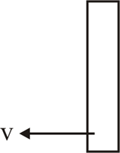Embibe Experts Solutions for Chapter: Centre of Mass, Momentum and Collisions, Exercise 1: Exercise-1
Embibe Experts Physics Solutions for Exercise - Embibe Experts Solutions for Chapter: Centre of Mass, Momentum and Collisions, Exercise 1: Exercise-1
Attempt the practice questions on Chapter 9: Centre of Mass, Momentum and Collisions, Exercise 1: Exercise-1 with hints and solutions to strengthen your understanding. Alpha Question Bank for Medical: Physics solutions are prepared by Experienced Embibe Experts.
Questions from Embibe Experts Solutions for Chapter: Centre of Mass, Momentum and Collisions, Exercise 1: Exercise-1 with Hints & Solutions
A particle of mass moving towards waste with a velocity collides with another particle of the same mass moving towards the north with the same speed and adheres to it. The velocity of the combined particle is,
An iron ball of mass moving at a speed of strikes a wall at angle of and reflects at the same angle. If ball and wall remain in contact for the force exerted on the wall will be,
When two bodies collide elastically, then:
In an elastic collision in absence of external force, which of the following is/are correct.
A block of mass moving with the velocity along a frictionless horizontal track and a block of mass moving with velocity collides elastically. The final speed of the block is:


A particle of mass moves with velocity towards a wall that is moving with velocity If the particle collides with the wall elastically, the speed of the particle just after the collision is:


Two particles and of masses and , respectively are moving along the same straight line with velocities , respectively in the same direction. After elastic collision the velocities of and are and in the direction of initial motion. Then


In a perfectly inelastic direct collision maximum transfer of energy takes place if,
